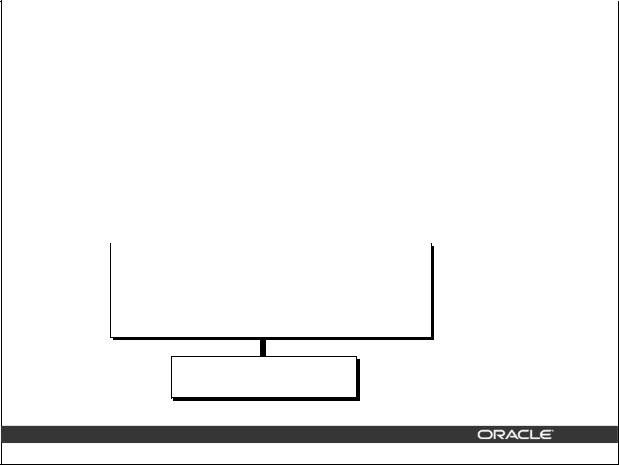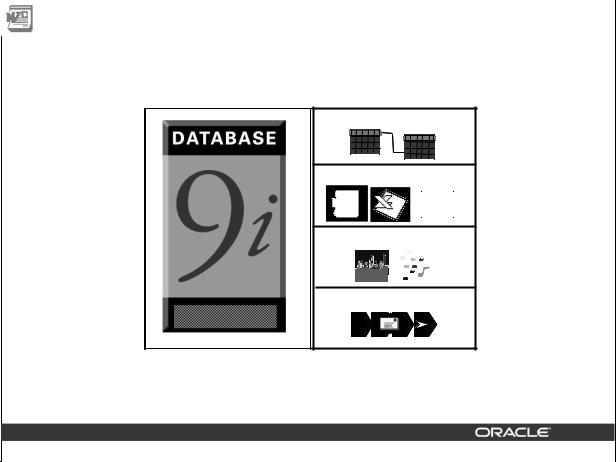
Semestr2 / 1 - Oracle / Student_1-8
.pdf
Languages Curriculum for Oracle9i
|
|
Introduction to |
or |
Introduction to Oracle9i |
|
Oracle9i: SQL for |
||||||||
|
|
|
||||||||||||
|
|
Oracle9i: SQL |
|
End Users |
||||||||||
|
|
|
|
|
|
|
|
|
for |
|
||||
|
|
Introduction |
Oracle9i: |
|
|
|
|
Experienced SQL Users |
|
inClass |
||||
|
|
to Oracle9i: |
Advanced |
|
|
|
|
|
|
|
|
|
|
|
|
|
SQL Basics |
SQL |
|
|
|
|
|
|
|
|
|
|
|
|
|
|
|
|
|
|
|
inClass |
|
|
||||
|
|
|
|
|
|
|
|
|
|
|
||||
|
|
|
inClass |
|
|
|
|
|
||||||
|
|
|
|
|
|
|
|
|
|
|
|
|||
|
|
|
|
|
|
|
|
|
|
|
|
|
|
|
|
|
|
|
|
|
|
|
|
|
|
|
|
|
|
|
|
|
|
|
|
|
|
|
|
|
|
|
|
|
|
|
|
|
|
|
|
|
|
|
|
|
|
|
|
Oracle9i: Program with PL/SQL
|
Oracle9i: PL/SQL |
|
|
|
Oracle9i: Develop PL/SQL |
|
|
|
|
||
|
Fundamentals |
|
|
|
Program Units |
|
|
|
|
|
|
|
|
inClass |
|||
Oracle9i: Advanced PL/SQL
inClass
Copyright © Oracle Corporation, 2001. All rights reserved.
Integrated Languages Curriculum
Introduction to Oracle9i: SQL consists of two modules, Introduction to Oracle9i: SQL Basics and Oracle9i: Advanced SQL. Introduction to Oracle9i: SQL Basics covers creating database structures and storing, retrieving, and manipulating data in a relational database. Oracle9i: Advanced SQL covers advanced SELECT statements, Oracle SQL and iSQL*Plus Reporting.
For people who have worked with other relational databases and have knowledge of SQL, another course, called Introduction to Oracle9i for Experienced SQL Users is offered. This course covers the SQL statements that are not part of ANSI SQL but are specific to Oracle.
Oracle9i: Program with PL/SQL consists of two modules, Oracle9i: PL/SQL Fundamentals and Oracle9i: Develop PL/SQL Program Units. Oracle9i: PL/SQL Fundamentals covers PL/SQL basics including the PL/SQL language structure, flow of execution and interface with SQL. Oracle9i: Develop PL/SQL Program Units covers creating stored procedures, functions, packages, and triggers as well as maintaining and debugging PL/SQL program code.
Oracle9i: SQL for End Users is directed towards individuals with little programming background and covers basic SQL statements. This course is for end users who need to know some basic SQL programming.
Oracle9i: Advanced PL/SQL is appropriate for individuals who have experience in PL/SQL programming and covers coding efficiency topics, object-oriented programming, working with external code, and the advanced features of the Oracle supplied packages.
Introduction to Oracle9i: SQL Basics Curriculum Map - 3

Languages Curriculum for Oracle9i
|
|
|
Introduction to |
or |
|
Introduction to Oracle9i |
|
Oracle9i: SQL for |
||||||||
|
|
|
|
|
||||||||||||
|
|
|
Oracle9i: SQL |
|
|
|||||||||||
|
|
|
|
|
End Users |
|||||||||||
|
|
|
|
|
|
|
|
|
|
|
for |
|
||||
|
|
|
Introduction |
Oracle9i: |
|
|
|
|
|
Experienced SQL Users |
|
inClass |
||||
|
|
|
to Oracle9i: |
Advanced |
|
|
|
|
|
|
|
|
|
|
|
|
|
|
|
|
|
|
|
|
|
|
|
||||||
|
|
|
SQL Basics |
SQL |
|
|
|
|
|
|
|
|
|
|
|
|
|
|
|
|
|
|
|
|
|
|
inClass |
|
|
||||
|
|
|
|
|
|
|
|
|
|
|
|
|
||||
|
|
|
|
inClass |
|
|
|
|
|
|
||||||
|
|
|
|
|
|
|
|
|
|
|
|
|
|
|||
|
|
|
|
|
|
|
|
|
|
|
|
|
|
|
|
|
|
|
|
|
|
|
|
|
|
|
|
|
|
|
|
|
|
|
|
|
|
|
|
|
|
|
|
|
|
|
|
|
|
|
|
|
|
|
|
|
|
|
|
|
|
|
|
|
|
|
|
Oracle9i: Program with PL/SQL
|
Oracle9i: PL/SQL |
|
|
|
Oracle9i: Develop PL/SQL |
|
|
|
|
||
|
Fundamentals |
|
|
|
Program Units |
|
|
|
|
|
|
|
|
inClass |
|||
Oracle9i: Advanced PL/SQL
inClass
Copyright © Oracle Corporation, 2001. All rights reserved.
Integrated Languages Curriculum
The slide lists various modules and courses that are available in the languages curriculum. The following table lists the modules and courses with their equivalent TBTs.
Course or Module |
Equivalent TBT |
|
|
Introduction to Oracle9i: SQL |
Oracle SQL: Basic SELECT Statements |
Basics |
Oracle SQL: Data Retrieval Techniques |
|
Oracle SQL: DML and DDL |
Oracle9i: Advanced SQL |
Oracle SQL and SQL*Plus: Advanced SELECT Statements |
|
Oracle SQL and SQL*Plus: SQL*Plus and Reporting |
Introduction to Oracle9i for |
Oracle SQL Specifics: Retrieving and Formatting Data |
Experienced SQL Users |
Oracle SQL Specifics: Creating and Managing Database Objects |
Oracle9i: PL/SQL Fundamentals |
PL/SQL: Basics |
|
|
Oracle9i: Develop PL/SQL |
PL/SQL: Procedures, Functions, and Packages |
Program Units |
PL/SQL: Database Programming |
Oracle9i: SQL for End Users |
SQL for End Users: Part 1 |
|
SQL for End Users: Part 2 |
Oracle9i: Advanced PL/SQL |
Advanced PL/SQL: Implementation and Advanced Features |
|
Advanced PL/SQL: Design Considerations and Object Types |
Introduction to Oracle9i: SQL Basics Curriculum Map - 4

Introduction
Copyright © Oracle Corporation, 2001. All rights reserved.

Objectives
After completing this lesson, you should be able to do the following:
•
•
List the features of Oracle9i
Discuss the theoretical and physical aspects of a relational database
•Describe the Oracle implementation of the RDBMS and ORDBMS
I-2 |
Copyright © Oracle Corporation, 2001. All rights reserved. |
Lesson Aim
In this lesson, you gain an understanding of the relational database management system (RDBMS) and the object relational database management system (ORDBMS). You are also introduced to the following:
•SQL statements that are specific to Oracle
•iSQL*Plus, which is used for executing SQL and for formatting and reporting purposes
Introduction to Oracle9i: SQL Basics I-2

Oracle9i
Scalability |
One |
|
vendor |
||
|
|
One |
Reliability |
management |
|
interface |
Single |
Common |
development |
|
model |
skill sets |
I-3 |
Copyright © Oracle Corporation, 2001. All rights reserved. |
Oracle9i Features
Oracle offers a comprehensive high-performance infrastructure for e-business. It is called Oracle9i. Oracle9i includes everything needed to develop, deploy, and manage Internet applications.
Benefits include:
•Scalability from departments to enterprise e-business sites
•Robust, reliable, available, secure architecture
•One development model, easy deployment options
•Leverage an organization’s current skillset throughout the Oracle platform (including SQL, PL/SQL, Java, and XML)
•One management interface for all applications
•Industry standard technologies, no proprietary lock-in
Introduction to Oracle9i: SQL Basics I-3

Oracle9i
|
|
|
|
|
|
|
|
|
|
|
|
|
|
|
|
|
|
|
|
|
|
|
|
|
|
|
|
|
|
|
|
|
|
|
I-4 |
Copyright © Oracle Corporation, 2001. All rights reserved. |
|||||
Oracle9i
There are two products, Oracle9i Application Server and Oracle9i Database, that provide a complete and simple infrastructure for Internet applications.
Introduction to Oracle9i: SQL Basics I-4

Oracle9i Application Server
A P A C H E
Portals
Transactional Apps
Business intelligenceI
Integration
|
|
|
|
I-5 |
Copyright © Oracle Corporation, 2001. All rights reserved. |
||
Oracle9i Application Server
The Oracle9i Application Server (Oracle9iAS) runs all your applications. The Oracle9i Database stores all your data.
Oracle9i Application Server is the only application server to include services for all the different server applications you will want to run. Oracle9iAS can run your:
•Portals or Web sites
•Java transactional applications
•Business intelligence applications
It also provides integration between users, applications, and data throughout your organization.
Introduction to Oracle9i: SQL Basics I-5

Oracle9i Database
Object Relational Data
Documents
XML
Multimedia
Messages
|
|
|
|
|
|
|
|
|
I-6 |
Copyright © Oracle Corporation, 2001. All rights reserved. |
|
Oracle9i Database
The roles of the two products are very straightforward. Oracle9i Database manages all your data. This is not just the object relational data that you expect an enterprise database to manage. It can also be unstructured data like:
•Spreadsheets
•Word documents
•PowerPoint presentations
•XML
•Multimedia data types like MP3, graphics, video, and more
The data does not even have to be in the database. Oracle9i Database has services through which you can store metadata about information stored in file systems. You can use the database server to manage and serve information wherever it is located.
Introduction to Oracle9i: SQL Basics I-6

Relational and Object Relational Database
Management System
•
•
•
•
•
Relational model and object relational model User-defined data types and objects
Fully compatible with relational database Support of multimedia and large objects High-quality database server features
I-7 |
Copyright © Oracle Corporation, 2001. All rights reserved. |
About the Oracle Server
The Oracle9i server supports both the relational and object relation models.
The Oracle server extends the data modeling capabilities to support an object relational database model that brings object-oriented programming, complex data types, complex business objects, and full compatibility with the relational world.
It includes several features for improved performance and functionality of online transaction processing (OLTP) applications, such as better sharing of run-time data structures, larger buffer caches, and deferrable constraints. Data warehouse applications will benefit from enhancements such as parallel execution of insert, update, and delete operations; partitioning; and parallel-aware query optimization. Operating within the Network Computing Architecture (NCA) framework, Oracle9i supports client-server and Web-based applications that are distributed and multitiered.
Oracle9i can scale tens of thousands of concurrent users, support up to 512 petabytes of data (a petabyte is 1,000 terabytes), and can handle any type of data, including text, spatial, image, sound, video, and time series as well as traditional structured data.
For more information, see Oracle9i Concepts.
Introduction to Oracle9i: SQL Basics I-7

Oracle Internet Platform
Clients |
Any mail |
|
Any browser |
client |
Any FTP client |
managementSystem |
Internet applications |
toolsDevelopment |
|
|
|
||
|
Business logic |
Presentation and |
|
|
and data |
business logic |
|
|
Databases |
Application |
|
|
|
servers |
|
|
Network services |
|
|
I-8 |
Copyright © Oracle Corporation, 2001. All rights reserved. |
SQL
PL/SQL
Java
Oracle Internet Platform
Oracle offers a comprehensive high-performance Internet platform for e-commerce and data warehousing. This integrated platform includes everything needed to develop, deploy, and manage Internet applications. The Oracle Internet Platform is built on three core pieces:
•Browser-based clients to process presentation
•Application servers to execute business logic and serve presentation logic to browser-based clients
•Databases to execute database-intensive business logic and serve data
Oracle offers a wide variety of the most advanced graphical user interface (GUI) driven development tools to build business applications, as well as a large suite of software applications for many areas of business and industry. Stored procedures, functions, and packages can be written by using SQL, PL/SQL, or Java.
Introduction to Oracle9i: SQL Basics I-8
